Joy Neal Kidney's Blog, page 49
September 14, 2022
Leora Wilson writing in her Diary
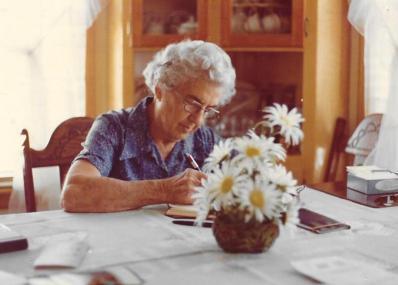 Leora Goff Wilson, Guthrie Center, Iowa, writing in Diary Book. Sept. 24, 1976. Taken by Delbert Goff Wilson of Fremont, CAI’m thankful that Uncle Del took this photo of his mother. I’ve posted it several times, but just recently remembered that I’ve become the “keeper” of her diaries! Inside the cover of the1976 diary, she noted that my sister Gloria gave it to her for Christmas in 1975.Another note said that she had been to patch at the hospital 318 times from 1957-1976, 42 times during 1975.Grandma Leora began September that year by cleaning and making up the bed in the basement, spading a spot for planting 30 bulbs, walking several blocks to the post office to mail birthday cards to two of her five Goff brothers (she remembered everyone’s birthdays), dug around the seedless ash to add wood chips, and watched the parade for the Guthrie County Fair.Son Delbert and Evelyn arrived from California on the 6th, to stay for three weeks. Delbert fixed so many things in the house (basement light, sunroom door latch, bathroom fan, caulking), even stretched his mother’s clothesline. Friends and relatives came to visit with Delbert and Evelyn. A week later, Donald and Rose (and dog Mitzi) came for a week. (They slept in the basement.) Leora relished all the visitors, phonecalls, going places. And capturing it all in her orange diary.“Seems like a dream,” she wrote, “to have all here.”
Leora Goff Wilson, Guthrie Center, Iowa, writing in Diary Book. Sept. 24, 1976. Taken by Delbert Goff Wilson of Fremont, CAI’m thankful that Uncle Del took this photo of his mother. I’ve posted it several times, but just recently remembered that I’ve become the “keeper” of her diaries! Inside the cover of the1976 diary, she noted that my sister Gloria gave it to her for Christmas in 1975.Another note said that she had been to patch at the hospital 318 times from 1957-1976, 42 times during 1975.Grandma Leora began September that year by cleaning and making up the bed in the basement, spading a spot for planting 30 bulbs, walking several blocks to the post office to mail birthday cards to two of her five Goff brothers (she remembered everyone’s birthdays), dug around the seedless ash to add wood chips, and watched the parade for the Guthrie County Fair.Son Delbert and Evelyn arrived from California on the 6th, to stay for three weeks. Delbert fixed so many things in the house (basement light, sunroom door latch, bathroom fan, caulking), even stretched his mother’s clothesline. Friends and relatives came to visit with Delbert and Evelyn. A week later, Donald and Rose (and dog Mitzi) came for a week. (They slept in the basement.) Leora relished all the visitors, phonecalls, going places. And capturing it all in her orange diary.“Seems like a dream,” she wrote, “to have all here.”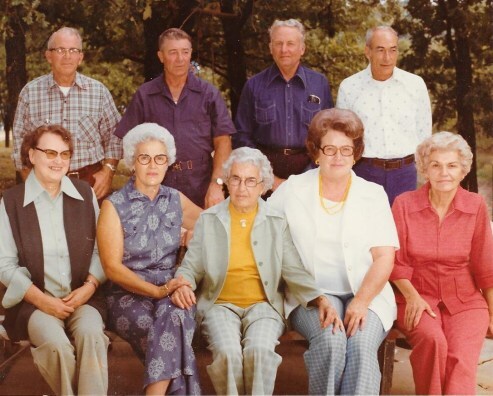 On the left are Donald and Rose Wilson from WA. Sam and Darlene (Wilson) Scar, Dexter, Iowa. Leora is in the middle. Then Warren and Doris (Wilson) Neal, Dexter. On the right are Delbert and Evelyn Wilson from CA. Taken at Darlene and Sam’s September 19, 1976
On the left are Donald and Rose Wilson from WA. Sam and Darlene (Wilson) Scar, Dexter, Iowa. Leora is in the middle. Then Warren and Doris (Wilson) Neal, Dexter. On the right are Delbert and Evelyn Wilson from CA. Taken at Darlene and Sam’s September 19, 1976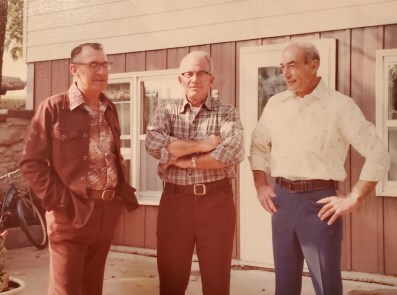 Former classmates (1933) and shipmates (1930s) Howard Benz, Donald Wilson, and Delbert Wilson. Diamondhead Lake, Guthrie County, Iowa, September 1976They spent one Sunday at Darlene and Sam’s at their home at Diamondhead Lake. Leora’s brother C.Z. Goff, and nephew, Merrill Goff, came from Omaha. Howard Benz, high school classmate and shipmate (USS Chicago CA-29) also stopped to see Del and Don.
Former classmates (1933) and shipmates (1930s) Howard Benz, Donald Wilson, and Delbert Wilson. Diamondhead Lake, Guthrie County, Iowa, September 1976They spent one Sunday at Darlene and Sam’s at their home at Diamondhead Lake. Leora’s brother C.Z. Goff, and nephew, Merrill Goff, came from Omaha. Howard Benz, high school classmate and shipmate (USS Chicago CA-29) also stopped to see Del and Don.
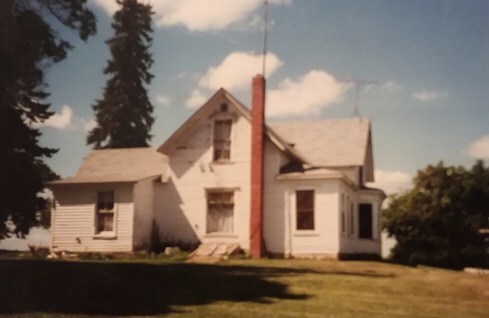 September 20, the four siblings drove to Monteith with their mother to see the house just west of town where Leora’s mother grew up. Clabe and Leora also lived there when they first married, in 1914. The group also visited the nearby pioneer cemetery, where Leora’s Jordan grandparents are buried, as well as her Grandpap Goff.
September 20, the four siblings drove to Monteith with their mother to see the house just west of town where Leora’s mother grew up. Clabe and Leora also lived there when they first married, in 1914. The group also visited the nearby pioneer cemetery, where Leora’s Jordan grandparents are buried, as well as her Grandpap Goff.
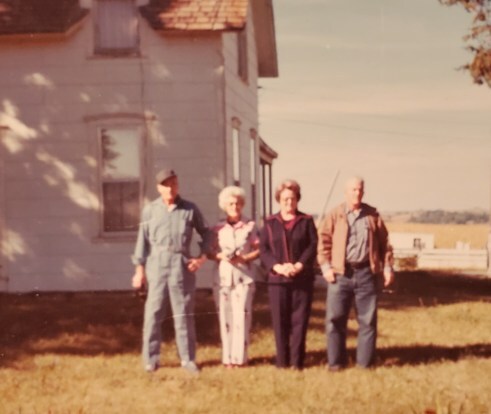 Delbert, Darlene, Doris, and Donald Wilson
Delbert, Darlene, Doris, and Donald WilsonAfter all this whirlwind of visits, Darlene left with Delbert and Evelyn on the 26th, to visit a son in Colorado. It was a Sunday, when Grandma felt more lonely after church. Doris and Warren drove up from Dexter to take her to church, then to The Port on the east side of Lake Panorama at Panora for for dinner. “Sure helped me from getting such a lonely feeling after Delbert & Evelyn & Darlene left.”
The last week of September, Leora went to a funeral, canned a little tomato juice, cut back the peonies and iris, filled three clothes lines with all the bedding she’d washed (and hauled up from the basement), and went to the hospital to help patch with the Rebekahs. (They still have a small hospital. That group of ladies volunteered regularly to patch hospital gowns, sheets, anything else that needed sewing. Leora was in charge of the treadle sewing machine.)
What a sturdy and courageous woman at age 85! I’m so blessed to be her oldest granddaughter, and the “keeper” of her stories.
Leora’s Letters is the story of the Wilson family during World War II. All five brothers served. Only two came home.
Leora’s Dexter Story takes place during the scarcity years of the Great Depression.
Leora’s Early Years tells her childhood stories, also Clabe Wilson’s, their marriage and first seven children.
September 2, 2022
Did “close application to work and studies” cause the death of Georgia Goff, age 28?
Leora was the oldest of the ten Goff children. She had two sisters. Georgia Laurayne was four years younger, and Leora was nearly 10 when Ruby Belle was born. She said that Georgia was the only nearly blonde one in the family.
From Leora’s memoirs: “Georgia was hurt by falling downstairs while we lived at Key West [Minnesota]. She was about 9 years old. She went upstairs to ‘make the beds’–spread them up. She got her job finished and, like young ones are apt to do, two beds were just right to hold to each foot of the bed and swing. Georgia did that, as she could remember, and lost her hold some way and fell and bumped her head on the foot of the bed or the floor. Then she sat at the top of the stairsteps and fainted and fell down the stairs.
“Mamma and I were doing things in the kitchen and heard a bump sound on the stair door and then another sound. Mamma said, ‘I wonder what Georgia is throwing downstairs,’ and went to see, and Georgia rolled down unconscious. I rushed to get cold water and cloth while Mamma was putting her on a couch. Georgia ‘came to’ in a little while, but felt kind of sick for awhile. We never got a doctor. She got a bad bump on her forehead.”
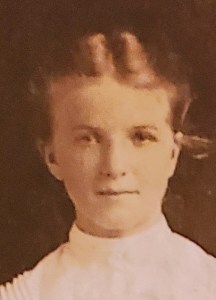 Georgia Goff, about age 13, 1907, Audubon, Iowa
Georgia Goff, about age 13, 1907, Audubon, IowaIowa
The family moved back to Iowa. Georgia and Ruby, as well as their older brothers, weren’t allowed to go to high school. But when their parents eventually moved to a Victorian house in Guthrie Center, the sisters studied piano and took other classes at Des Moines University, although Georgia had “spells” once in a while. According to her older sister, she could attend a lecture and remember nearly the entire thing.
The Goff sisters also worked for the Carl Weeks family, who later built the Des Moines treasured Salisbury House. Georgia accompanied the family to Clear Lake in 1921 to help with their active sons. Later, she gave piano lessons in Guthrie, but she eventually had to give up those lessons, and a beau, when the spells worsened.
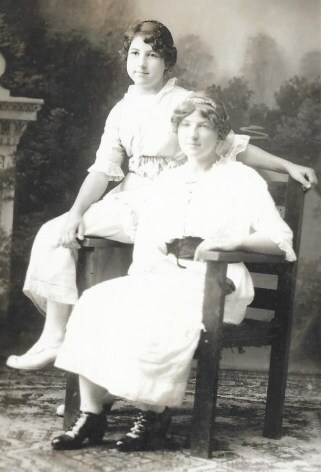 Ruby and Georgia Goff
Ruby and Georgia GoffTheir mother, Laura Goff, thought maybe having a diversion would help Georgia feel better, so her daughters had sister portraits taken in fancy clothing.
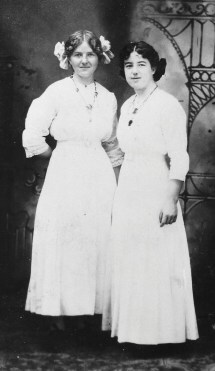 Georgia and Leora Goff Wilson
Georgia and Leora Goff WilsonAt his wit’s end, Sherd Goff took his daughter to Clarinda Mental Hospital, where she was admitted August 22, 1922.
A letter from the Clarinda Treatment Complex states that Georgia Goff was intelligent and obedient to her parents, was a student of music and dramatic art, and also studied “applied psychology by intensive concentration.” The reason for admission: “Over study and nervous breakdown.” Diagnosis: “Manic Depressive Psychosis: Mania.”
Congestion of the brain
She died September 7, 1922. Cause of death: “Exhaustion and acute Mania: Congestion of the brain.” Her funeral was held in the parlor of the Victorian home.
The house was full of mourners because 28-year-old Georgia had taught piano to the children of so many families. She was the first of the family buried in Union Cemetery.
In Outliers, Malcolm Gladwell states that early educational reformers were concerned that students could get too much schooling. A study of 1741 cases of insanity by Edward Jarvis, published by the US Commissioner of Education in 1871, concluded that “over-study” was responsible for 205 of the cases. He wrote, “Education lays the foundation of a large portion of the causes of mental disorder.”
Even pioneer of public education Horace Mann believed that “Not infrequently is health itself destroyed by over-stimulating the mind.” Education journals worried about overtaxing students! Was this mindset still common 50 years later?
Do you suppose that Georgia Goff might have suffered from a brain tumor instead?
From: Leora’s Early Years: Guthrie County Roots
August 31, 2022
Report of Major Accident – F/O Claiborne J. Wilson
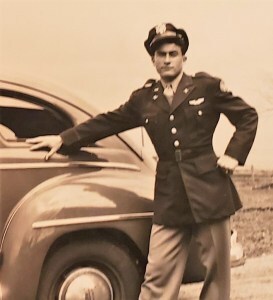 Junior Wilson’s last furlough home, right after receiving his pilot’s wings. March 1945, Perry, Iowa. His folks had just received a telegram that his brother Dan Wilson was MIA in Austria. Another brother, Dale, had been missing in New Guinea since November 1943.
Junior Wilson’s last furlough home, right after receiving his pilot’s wings. March 1945, Perry, Iowa. His folks had just received a telegram that his brother Dan Wilson was MIA in Austria. Another brother, Dale, had been missing in New Guinea since November 1943.In late 1989, I asked for the Junior Wilson’s August 1945 accident report. The Headquarters Air Force Inspection and Safety Center, Norton Air Force Base, CA, sent five pages of “releasable portions” and photocopies of nine photos. Reports of mishaps more than ten years old are stored on microfilm, they noted, “which does not lend itself to quality reproduction,” so most of the photos are too murky to make out anything.
ARMY AIR FORCES REPORT OF MAJOR ACCIDENT
“On 9 August 1945, F/O Claiborne J. Wilson was pilot of TP-40N-5CU aircraft AFF 42-105364, when the aircraft crashed and burned thirty (30) miles northwest of Aloe Army Air Field, Victoria, Texas. F/O Wilson was a member of a four (4) ship formation, which took off from Fannin Auxiliary Field individually and assembled over the field at 3,000 feet. F/O Wilson was flying number four (4) position. [words blacked out] F/O Wilson was rather slow in joining the formation, but {word blackened] he reported no difficulty whatsoever over the radio. The formation climbed to 10,000 feet and made a series of ninety (90) and 180 degree turns. As the formation completed one (1) 180 degree turn, the officer flying number three (3) position noticed that F/O Wilson was not on his wing. At about the same time the instructor noticed his absence also. The instructor immediately called number three (3) man and asked him where F/O Wilson was. The officer in number three (3) position then looked around and states that he saw a P-40 aircraft off to his left and approximately 4,000 feet below the formation in what seemed to be a normal glide. This aircraft was the one piloted by F/O Wilson, who had said nothing over the radio that might indicate that he had engine trouble. The officer flying number three (3) position further states that there was no smoke coming from the aircraft, nor was there fire visible. The instructor leading the formation immediately began calling F/O Wilson, but received no reply. The instructor then dismissed the formation and went down to look for the aircraft piloted by F/O Wilson. At the time of this occurrence, the formation was flying above scattered clouds, and the aircraft piloted by F/O Wilson had disappeared below the clouds. The instructor then went below the clouds and circled and finally located Wilson’s aircraft, which had crashed and was burning approximately seven (7) miles south of Nordheim, Texas.
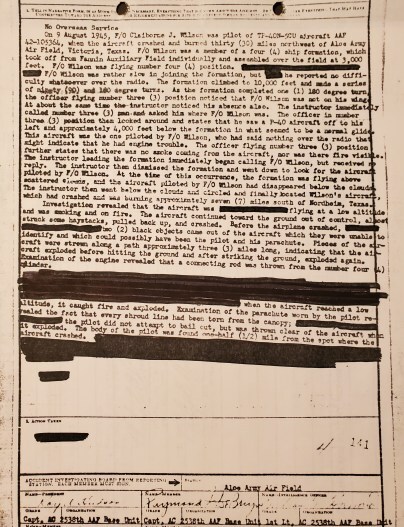 “Investigation revealed that the aircraft was [words blackened] flying at a low altitude and was smoking and on fire. The aircraft continued toward the ground out of control, almost struck some haystacks, pulled back up, and crashed. Before the airplane crashed, [blackened] two (2) black objects came out of the aircraft which they were unable to identify and which could possibly have been the pilot and his parachute. Pieces of the aircraft were strewn along a path approximately three (3) miles long, indicating that the aircraft exploded before hitting the ground and after striking the ground, exploded again. Examination of the engine revealed that a connecting rod was thrown from the number four (4) cylinder.
“Investigation revealed that the aircraft was [words blackened] flying at a low altitude and was smoking and on fire. The aircraft continued toward the ground out of control, almost struck some haystacks, pulled back up, and crashed. Before the airplane crashed, [blackened] two (2) black objects came out of the aircraft which they were unable to identify and which could possibly have been the pilot and his parachute. Pieces of the aircraft were strewn along a path approximately three (3) miles long, indicating that the aircraft exploded before hitting the ground and after striking the ground, exploded again. Examination of the engine revealed that a connecting rod was thrown from the number four (4) cylinder.
“[Four lines blackened] when the aircraft reached a low altitude, it caught fire and exploded. Examination of the parachute worn by the pilot revealed the fact that every shroud line had been torn from the canopy; [words blackened] the pilot did not attempt to bail out, but was thrown clear of the aircraft when it exploded. The body of the pilot was found one-half (½) mile from the spot where the aircraft crashed. [Three lines blackened, as well as the next word] and whatever was listed in ‘Action Taken’.”
 An official photo of the wrecked P-40
An official photo of the wrecked P-40

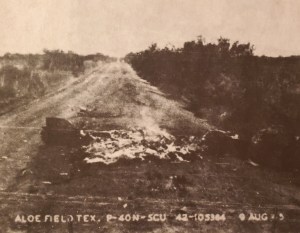
I shared the document with my mother, Junior’s older sister, but I didn’t show her any of the photos. Doris had nightmares after the war, crying out for Junior to jump sooner. Photos of her brothers were displayed on bookshelves at home, but when she’d sink into depression because of those reminders, she’d put them in a drawer.
August 29, 2022
Food Shortages During World War I
 Donald, Clabe holding Doris, and Delbert Wilson on the back porch of the house “down on Beaver,” belonging to Leora’s brothers who were serving with the 88th Division in France. The contraption to the right is Leora’s hand-cranked washing machine.
Donald, Clabe holding Doris, and Delbert Wilson on the back porch of the house “down on Beaver,” belonging to Leora’s brothers who were serving with the 88th Division in France. The contraption to the right is Leora’s hand-cranked washing machine.Leora seemed to always have a batch of bread “set” on the evening before her babies were born, to bake the next morning. Her mother was there for the birth and to help out for a few days. When Doris was born, in August of 1918, Grandmother Laura Goff made rolls out of some of the dough and baked them and loaves of bread the next morning. When little Delbert and Donald, ages 3 and 2 came in from playing, they could smell the aroma of baking bread. Of course, they each wanted a roll. Then another one. Grandmother said, “Oh, you’ll eat up all and your Daddy won’t have any.”
Donald said, “He can eat con-bread,” meaning cornbread. Food was rationed during the war, and flour was stretched by adding other grains. Bread made from it didn’t keep long–it soured quickly and was sticky.

The government encouraged replacing wheat bread with cornbread.
In fact, “An Appeal to the People” by Herbert Hoover, United States Food Administration, was published in local papers throughout the nation in June, encouraging reduction in consumption of food. “But the situation with regard to wheat is the most serious in the food supply of the Allied world. . consumption . . . must be reduced to approximately one-third of normal.”
He stressed that “it is imperative that all those whose circumstances permit shall abstain from wheat and wheat products in any form until the next harvest.”
The newspaper included a list of substitutes for one cup of wheat flour:
barley 1 ¾ cupbuckwheat ⅞ cup
corn flour 1 scant cup
corn meal, coarse ⅞ cup
corn meal, fine one scant cup
corn starch ¾ cup
rice flour ⅞ cup
rolled oats 1 ½ cup
rolled oats ground in meat chopper 1 ½ cup
soybean flour ⅞ cup
sweet potato flour 1 ½ cup
“This table will help you to make good griddle cakes, muffins, cakes, cookies, drop biscuit, and nut or raisin bread without using any wheat flour.”
The newspaper also included a muffin recipe:
Rice and Barley Muffins
1 egg
1 cup of milk
1 tablespoon fat
2 tablespoons syrup
4 teaspoons baking powder level
1 teaspoon salt
1 cup rice flour
1 ½ cup barley flour
Beat egg, add milk, fat and syrup, combine with sifted dry ingredients, bake 20 to 30 minutes in hot oven. These are very delicious, the recipe added.

Delbert and Donald asked their grandmother if they could take the new baby for a ride in their wagon. “Let’s ask your mamma.” They tiptoed into the bedroom, where the boys bumped up against the bed to ask their question. Leora answered that baby Doris needed to get bigger first, so they skipped back outside to play.
From Leora’s Early Years: Guthrie County Roots
August 26, 2022
Dad’s 1939 Chevy (AKA C-39)
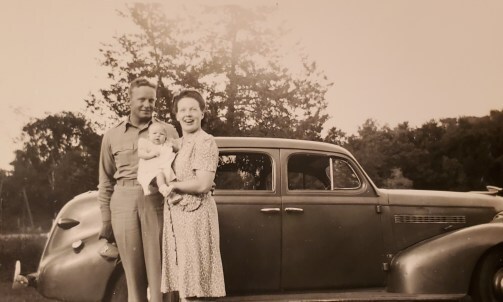 Dad was stopped in one town and warned that a tire had a dangerous bulge. They couldn’t buy new tires in those days so they had it patched it.The gas gauge didn’t work and they ran out of gas 10 miles from Marfa, Texas. It was dark. Mom and I stayed in the car while he hitched a ride into town for gas!This is the first car I remember. When Dad bought the 1952 Chevy, the old one became his workhorse, carrying tools and farmer things. It had a knob on the dash to switch for the loud country horn and quieter city horn. The seats were a plush fabric and I can still smell the mustiness.(They dubbed it the C-39 because all the Army planes were designated with a letter and number. Dad’s brother flew 13 missions over the “Hump” in a real C-47.)—–Leora’s Letters: The Story of Love and Loss for an Iowa Family During World War II
Dad was stopped in one town and warned that a tire had a dangerous bulge. They couldn’t buy new tires in those days so they had it patched it.The gas gauge didn’t work and they ran out of gas 10 miles from Marfa, Texas. It was dark. Mom and I stayed in the car while he hitched a ride into town for gas!This is the first car I remember. When Dad bought the 1952 Chevy, the old one became his workhorse, carrying tools and farmer things. It had a knob on the dash to switch for the loud country horn and quieter city horn. The seats were a plush fabric and I can still smell the mustiness.(They dubbed it the C-39 because all the Army planes were designated with a letter and number. Dad’s brother flew 13 missions over the “Hump” in a real C-47.)—–Leora’s Letters: The Story of Love and Loss for an Iowa Family During World War II
August 22, 2022
Our One Vacation, the Black Hills, 1958
When I was a girl on an Iowa farm in the 1950s, we read items in The Dexter Sentinel that so-and-so had been to the Black Hills or to Estes Park. We knew people who actually took vacations during the summer.
We didn’t. Oh, there was the one Sunday when our pastor was gone, Mom packed a breakfast picnic and we headed for Madison County’s Pammel Park. She cooked breakfast on an open fire, Dad read the Sunday paper and took a nap. Gloria, two years younger, and I went for a hike and came back with lots of snails we’d found on tree trunks. Some vacation, huh!
In 1958, Mom got Dad to say okay to traveling to the Black Hills. But I was 14 then and didn’t want to go. I was at “that age” and didn’t want to ride all that way in the back seat with a pesky little sister. That changed when Mom suggested inviting Grandma Leora along.
Having Grandma along certainly improved my outlook.
 Joy, Grandma Leora, Gloria, at the Wyoming border. Aug. 20, 1958. Ladies always wore dresses in the 1950s.
Joy, Grandma Leora, Gloria, at the Wyoming border. Aug. 20, 1958. Ladies always wore dresses in the 1950s.Not only did Grandma ride in the middle of the back seat, she slept between Gloria and me at the motel.
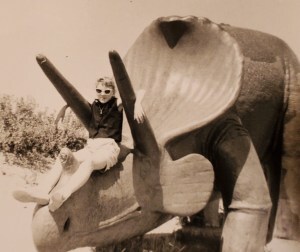 Gloria on a Triceratops at Rapid City’s Dinosaur Park, Aug. 19, 1958
Gloria on a Triceratops at Rapid City’s Dinosaur Park, Aug. 19, 1958Highlights: Rapid City, SD, with its School of Mines Museum and Dinosaur Park, a “Passion Play” at Spearfish, and Mount Rushmore.
On the way back, we looked over the old Air Force Base at Alliance, Nebraska, where Uncle Bill Neal, Dad’s brother, had been stationed during WWII.
We actually stayed gone for a week, August 17-23, 1958. I was the official keeper of mileage (1759.7 miles), what towns we went through, what we spent ($37.67 for gas, about $68.11 for food, $73 for 6 motels, $30 for a tire), even kept a diary of what we saw every day.
I’d always thought of this trip from the POV of a bratty teenager. An assignment in a writer’s class was to reframe a story from the past. The Black Hills story turned into a delightful memory about how the upbeat personality of one person can permeate things. Dad was willing to stop at places he would ordinarily have frowned at, even Wall Drug and the Corn Palace.
August 18, 2022
Gardens in the Family
Both Grandma Leora Wilson and Grandma Ruby Neal enjoyed gardening.
Grandma Ruby’s was along the east side of house on the farm near Dexter. She grew both vegetables and flowers, saving certain seeds, swapping them with relatives and friends. Once she gave me seed pods for Love in a Mist. Another time she shared Money Plant seeds. Mine didn’t turn out as well as hers, but they were fun to experiment with.
Both grandmothers kept many houseplants in their basements during the winter, then carried them outside during nice weather. Here’s a story about Grandma Ruby’s barrel cactus.
Grandma Leora had big vegetable gardens at Dexter and at Minburn, with help from everyone in the family. When she was widowed and moved to Guthrie Center, she chose trees and shrubs for the new little house and started a bed of vegetables. She added flowers and joined the Guthrie Center Garden Club. Even though she died in 1987, people remark about her beautiful flowers to this day.
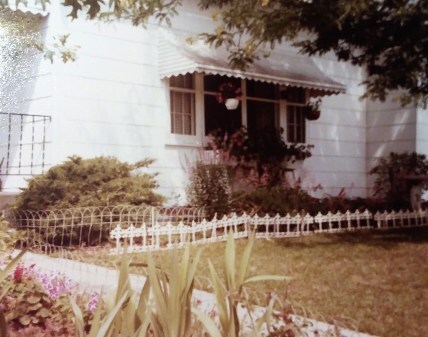 Grandma Leora’s front gardens in Guthrie Center, even vines in the window box. There was another larger garden in the back yard.
Grandma Leora’s front gardens in Guthrie Center, even vines in the window box. There was another larger garden in the back yard.We always had a garden plot, just outside the kitchen window on the farm. After she was widowed, her garden began to include as many flowers as vegetables.
Still going through boxes of her papers, I found two notes from a neighbor who lives a couple of miles up the gravel road. “Thank you for all the beauty you share with us,” she wrote. The other, from 2003, “Thank you for making a garden of beauty for all to enjoy. I often tell people to drive by Doris Neal’s – view the flowers.”
How nice of Lila to take the time to write the notes, which have become part of my mother’s keepsakes, reminding me again of her yucca and day lilies and pink peonies.
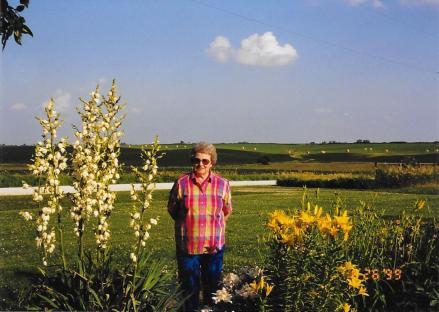 Mom with blooming yucca and a few of her many day lilies, 1999
Mom with blooming yucca and a few of her many day lilies, 1999 Mom, Grandma Leora, and Aunt Darlene gathered their spring flowers every year to take to the cemeteries in Guthrie Center and Perry for Memorial Day.
Mom, Grandma Leora, and Aunt Darlene gathered their spring flowers every year to take to the cemeteries in Guthrie Center and Perry for Memorial Day.
August 16, 2022
Autumn Moon (poem)

AUTUMN MOON
Flooded with moonlight
and treefrogs
of late summer
dew-spangled webs
of orb weavers
first school days in the air
the grumble of golden buses
a throbbing cadence of
early marching band
autumn nudging
as daylight shrinks
its progress measured
by that moon
August 12, 2022
Disowning Fibromyalgia
I’d rather say yes than to turn down an invitation to talk about the “Leora stories.” The latest was for a group in the evening and an hour out of town. These days, I need to say no.
Dealing daily with fibromyalgia is something I don’t like talking about, but last spring, I was invited to interview on PJNET. For new guests, the host does a trial run to make sure of computer connections and to get acquainted. When we went on the air, I expected to talk about Leora’s Letters, but the first thing he brought up was the fibromyalgia.
He said it’s part of my story. That I’m writing in spite of daily challenges.
I needed to think that through. It’s been part of my life for more than two decades. I know that God is with me in this. Mostly house bound because of daily symptoms, I guess I’ve tried to disown the suffering. When pain and exhaustion set in about every 3-4 hours, 25-minute nap usually calms them down. Yes, that’s three naps a day. Even in between, I don’t feel well enough to write, but sometimes, an hour or two a day, I’m lucid enough to tackle it.
The Onset
Before the onset of symptoms two decades ago, I wrote regularly and began getting paid for essays and articles. My goal was to eventually share the Wilson family World War II story, but I needed to learn to write, so I attended the summer writing festival at the University of Iowa several summers.
I regularly journaled first thing in the morning, including prayers. Some of those prayers during the 1990s included the Wilson family stories. One was that someday people might want to see where the stories took place. I remember thinking that was an audacious prayer. Who did I think I was, Laura Ingalls Wilder? (That’s what we fans have done, visit the places she lived.)
In 2001, I went downhill physically. Exhaustion. Pain–joints, bones, muscles. A painful bout of shingles. As the horrors of 9/11 were played out on TV, I watched with a heating pad against my afflicted ribs. That fall I gave my last program for a group of women.
The Miserable Middle Years

There’s no test for fibromyalgia, but that’s what the doctor listed. About all she could prescribe was something to mask the pain. I’d read that sufferers are usually women and that the condition lasted an average of seven years.
Brain fog set in as well. On my worst days, I couldn’t read or write. Sometimes the goal for the day was to take a shower. I begged God to heal me, reminding him that I’d certainly be more useful if he would.
I was sensitive to loud sounds, lights, music, and watching TV became impossible. The basement steps were a challenge, and getting into the bathtub was scary. Getting dressed to go anywhere was an ordeal, with extra discomfort for the next couple of days. So I mostly stayed home. Walking very far was hard. So was standing to do work in the kitchen.
As my husband (Guy) and I settled into how much I could tolerate, we realized that long trips were a thing of the past.
Sleep apena is also part of my story, as are several unrelated surgeries. I was still in the hospital after the worst one, for diverticulitis perforations, when God reminded me of his presence. Even during those darkest hours of misery, he was alongside.
These Days
About four years ago, the brain fog began to lift. My heart and head returned to the WWII story. Robin Grunder eventually helped shepherd it to publication. Right before it came out, all five Wilson brothers were remembered on the Dallas County Freedom Rock. They asked if I’d speak at the dedication. I gave two talks that month (October 2019) for the first time in 18 years.
But still, the more times I need to get into and out of a car for errands, the longer recovery time I need. I’m so thankful that my husband Guy does floors, chauffeurs, does the grocery shopping (all of it since my shoulder replacement in 2020), and everything else.
With lots of prayer and help, I’ve managed to self-publish two “Leora books,” and the third is due out next month. I am so amazed and humbled at this. One program or book club a month is about all I can handle, since it means “saving up energy” ahead of time, then a few days to recover afterwards.
Is there purpose in all this pain? Have I been trying to deny something precious? What if fibromyalgia is God’s way of getting me to stay home and write the stories no one else can? Grandma Leora’s stories? I’m grateful and humbled.
What if I’m to share about suffering, about living (and even thriving) in spite of pain?
I certainly have discovered blessings while feeling crummy. And because of fibro, I have a circle of encouraging internet friends I’ve never met. What a blessing!
. . . We rejoice in our sufferings, knowing that suffering produces endurance, and endurance produces character, and character produces hope. – Romans 5:4-5
I’m in the endurance stage, and I’ve got hope. Whether I’ve developed character through this is up to God, as is whether I’m able to write. Or anything else. Praise God from whom all blessings flow!
August 11, 2022
Jim Boll, the Man Who Rescues Windmills
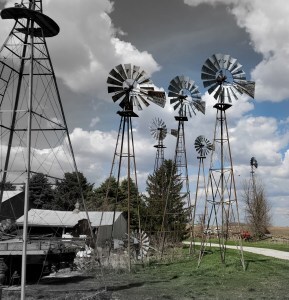
I asked who the man was in a photo taken at the dedication of the Dallas County Freedom Rock. He wore a knitted cap and was one of the first people to come up afterwards to talk to me. I’d been asked to talk about the Wilson brothers, who are remembered on one side of the memorial.
Jim Boll, I was told. Not only is he a Vietnam veteran, he’s known as the man who rescues windmills. The old Aermotors and other classic windmills we rural Iowans grew up with. They are dying out since electricity now pumps water on farms.
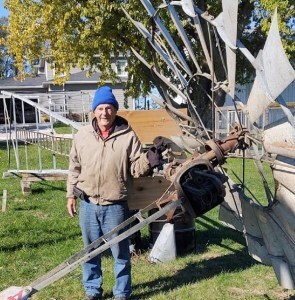 Jim started out with the one he played on as a kid. It later needed fixing, so he did it himself. Someone came by, saying he had one that needed repaired. That’s how it started, but he’s saved and mended well over 100 of them, some dating back to 1892.
Jim started out with the one he played on as a kid. It later needed fixing, so he did it himself. Someone came by, saying he had one that needed repaired. That’s how it started, but he’s saved and mended well over 100 of them, some dating back to 1892.
Boll has survived the Vietnam war and cancer. It’s a good thing he has no fear of heights, although he does use a safety harness for the taller windmills.
Once in a while he sells an old windmill. The Blank Park Zoo in Des Moines bought one. He repaired one on the Iowa State Fairgrounds.
 “My” windmill, where Dad rented a farm from Donald and Lucille Shaw. The address was Redfield, Iowa, but the you can see if from Dexfield Hill next to old Dexfield Park. The house is on the left, with the barn across the road.
“My” windmill, where Dad rented a farm from Donald and Lucille Shaw. The address was Redfield, Iowa, but the you can see if from Dexfield Hill next to old Dexfield Park. The house is on the left, with the barn across the road.I’m drawn to the silhouette of old windmills across a prairie, announcing a farm there or at one time an old homestead among the corn, elderberries, oats, sumac, and wheat fields. That old windmill drew water at one time for the life of a family and their livestock.
An old windmill was my first chore, at least that I can remember from age 4 or 5, that of trudging down a gravel road to wire the handle of the contraption to let the blades above catch the wind to pump our water up the hill to a holding tank.
You can see Jim Boll’s forest of windmills along Highway 44 in Dallas County, Iowa, between Grimes and Dallas Center. It’s a treat to get to see so many all at once.
Here’s a story about him from KCCI TV.



